#aground zero
Explore tagged Tumblr posts
Text
Aground Zero: Mining & Building Your Way to the Surface

Aground Zero voxel colony sim and base building RPG game for Linux and Windows PC hits Early Access. Thanks to the imaginative team at Fancy Fish Games for bringing this adventure to life. Available now via Steam Early Access with 85% Positive reviews. Fancy Fish has just rolled out their latest project, Aground Zero, the voxel colony sim. This isn't just another typical release; it's a unique base building RPG that's diving into Early Access for around a year. The world as we know it has crumbled. You find yourself deep underground, with nothing but isolation and a friendly AI companion for company. It's a scenario straight out of a sci-fi flick, but here's the twist – it's up to you to claw your way back to the surface. You'll be mining, building, and scraping together a survival strategy. But that's not all. There's a glimmer of hope in this bleak world – other survivors are out there, waiting for you to find them. The journey from being stranded in this subterranean nightmare to establishing your own underground base is just the beginning. You'll be piecing together vehicles, rescuing fellow survivors, and eventually, making your way to the surface. But what awaits you there? That's the big question. Fancy Fish isn't just stopping at the voxel colony sim release, they have big plans for Aground Zero. Think along the lines of crafting the first spaceship, exploring new areas, and even constructing a moon base. It's clear they're not just thinking big; they're thinking cosmic.
Aground Zero voxel colony sim release Trailer
youtube
Now, here's where it gets even more interesting. This underground world isn't just about mining and building. You're not alone down there. And I'm not just talking about other survivors. There are creatures lurking in the depths, the kind that don't belong on Earth. It adds an exciting, albeit slightly chilling, twist to your quest. But fear not, the AI companion is not just a bundle of code. It's your guide, your helper, and in these dire times, perhaps even your savior. All it needs is a bit of assistance from you, the human touch, to steer humanity towards safety. Aground Zero is more than just a solitary voxel colony sim journey. It's got a local split-screen multiplayer option, but here's the catch – only one player can use the keyboard and mouse. Everyone else? You're going to need a controller. And while it supports up to four players, everyone can opt for controllers if that's more your style. This game isn't just a sequel or a rehash. It's a 3D spinoff of the wildly successful Aground (2020), known for its engaging pixel-art mining and crafting gameplay. If you haven't played the original, no worries, jumping into Aground Zero requires no prior knowledge of the voxel colony sim. It's a standalone experience, set during the same events but with its own unique twist. Aground Zero is shaping up to be an exhilarating, engaging, and utterly unique voxel colony sim. Whether you're a seasoned Linux gamer or just looking for your next big adventure, this is one journey you won't want to miss. Available now via Steam Early Access. Priced at $19.99 USD / £16.75 / 19,50€. Along with support for Linux and Windows PC.
#aground zero#voxel colony sim#base building#rpg#linux#gaming news#fancy fish games#ubuntu#windows#pc#Youtube
4 notes
·
View notes
Text
Love to see my man haunting the narrative:
“No, by gum, it don’t,” agreed Silver; “not nat’ral, nor not nice, says you. Great guns! Messmates, but if Flint was living, this would be a hot spot for you and me. Six they were, and six are we; and bones is what they are now.”
“I saw him dead with these here deadlights,” said Morgan. “Billy took me in. There he laid, with penny-pieces on his eyes.”
“Dead—aye, sure enough he’s dead and gone below,” said the fellow with the bandage; “but if ever sperrit walked, it would be Flint’s. Dear heart, but he died bad, did Flint!”
“Aye, that he did,” observed another; “now he raged, and now he hollered for the rum, and now he sang. ‘Fifteen Men’ were his only song, mates; and I tell you true, I never rightly liked to hear it since. It was main hot, and the windy was open, and I hear that old song comin’ out as clear as clear—and the death-haul on the man already.”
“Come, come,” said Silver; “stow this talk. He’s dead, and he don’t walk, that I know; leastways, he won’t walk by day, and you may lay to that. Care killed a cat. Fetch ahead for the doubloons.”
We started, certainly; but in spite of the hot sun and the staring daylight, the pirates no longer ran separate and shouting through the wood, but kept side by side and spoke with bated breath. The terror of the dead buccaneer had fallen on their spirits.
Silver’s qualifications are killing me. He’s dead and his ghost doesn’t walk [that I know of]. [At least not by day.]
#absolutely nothing about the circumstances of flint’s death makes any sense even solely in the context of treasure island#(the pirates were all there? billy somehow ended up with the map? and went into hiding in england instead of going after the treasure?)#that said it also makes zero sense that jim could sail a three masted schooner by himself even to run her aground lol#stevenson seems to have been operating firmly in shhhh don’t question it as long as it makes a fun story mode#treasure island liveblog i guess#black sails#undeath tag#my posts
5 notes
·
View notes
Note
I really hope you’ll write Peter Pan in Rainbow Valley! You’re the most qualified to match Barrie’s and Montgomery’s respective tones, all your fics are very whimsical and funny. I’d LOVE to read it.
Lol! Oh, thank youuu. That’s so nice! 🥹 And just so you know, I’m really happy to have another J.M. Barrie mutual, I feel like we’re kind of thin on the ground on tumblr. I follow all his tags here, and they’re so rarely added to.
I like half drafted an outline on this, and will keep it in the future-maybe-someday file for ‘fics that want to be written,’ but it’s a real purgatory over there, if I’m being honest. But outlining it has admittedly taken zero effort, because these two stories almost seem meant to be joined. We know Maud was a huge fan of J.M. Barrie, and by extension of Peter and Wendy… and I’ve long personally thought that it was beyond pure coincidence that ‘James Matthew Blythe’ is so similar in name to ‘James Matthew Barrie’… but even Rainbow Valley (place not book), which is kind of this liminal space between fairyland and reality, sacred to childhood and play, has some existing Neverlandness about it already built in. And then there’s these compelling similarities between Mrs. Darling and Mrs. Anne Blythe as well; both charming mothers, both adult advocates for/in/of imagination, and both wonderful storytellers (Peter lingers around the eaves of the Darlings Bloomsbury home to hear her stories) that are devotedly loved by their husbands and children. But for me, I think it's a huge (the hugest) point of interest to loop in Walter, who saw the Piper, like really really saw him, in Rainbow Valley. How easy it would be to kick out the German Pied Piper and drawn in Peter Pan and his flute, instead… two characters who are already deeply linked by folklore. Elsewhere, if the Jolly Roger, did take a wrong star and run aground in the Rainbow Valley brook, it’s just asking to have the suspended-in-time Neverland pirates be familiar with Captain Jim and maybe Lost Margaret, from bygone Life-Book days. I’d even give Shirley a boyish thimble-passing romance with Tiger Lily, the same way I’ve always wanted to see him paired off with a Mi’kmaq girl. Aunt Mary Maria’s hand also shoots right up for the doubling Hook-ish authoritarian/‘grow up already’/take-all-the-fun-away role (Gilbert would never suit it the way Mr. Darling did). But anyway! With all this low hanging fruit, it’d seriously be so simple to neatly tuck these two books into each other at every corner. It’s really all right there.
26 notes
·
View notes
Text
Me: I’m going to write this summer, the second I get back to my desk it’s going to happen, words will spring forth like water from a dam-
Narrator: she has not written a single word of the new chapter. The doc’s word count is zero. Google Docs is a terrifying place. The ship has run aground. Wait for rescue.
6 notes
·
View notes
Text
Chapter 203 Trivia
Happy 4th of July from Dr. Xeno*!
(*Indirectly.)


Fluorite mines still exist in Japan, however they're far inland so the KoS can't make use of their boat routes for transport.
Fluorite is one of the first materials shown to fluoresce (=glow when light/EM radiation hits it), which is what the phenomenon was named after!
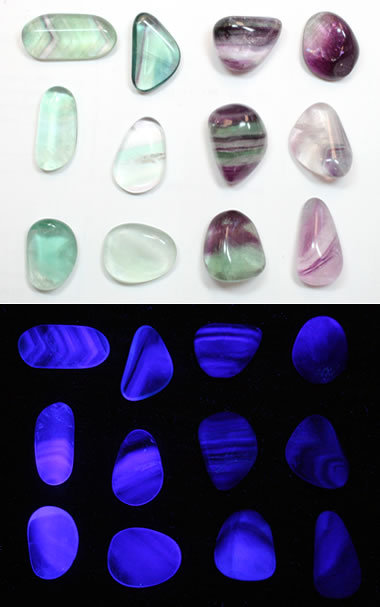


One of the major problems in improving telescope quality is getting rid of chromatic aberration, which can be improved by using lenses with a lower refractive index (such as those made of fluorite rather than glass). This bends the light less, leading to clearer magnification.
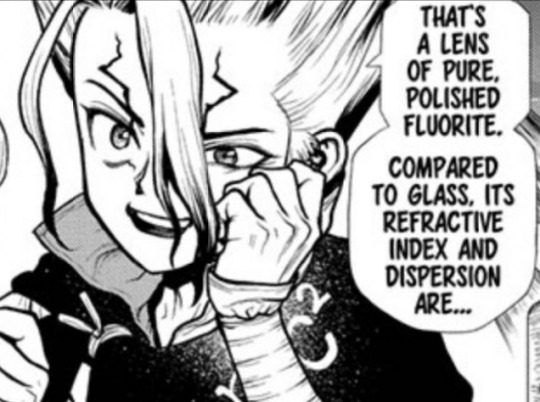

The rocket design is similar to cruise missiles, in that it uses a jet engine rather than a rocket engine. Cruise missiles will follow an almost direct path to their target, and have the ability to adjust direction at any point. Ballistic missiles cannot.



The blocky thing shown here could be a stylized vacuum column tape drive, a device for storing data on magnetic tape (the black ribbon in cassettes) to be used in computations.
One of these devices is the IBM 7090, which was used by NASA to control space flights in the 60s.


The map shows that the KoS may be aiming to land around Goa in India.
Assuming they don't stop, the journey via the Suez is >10 days, and >23 days via the Cape of Good Hope.

The Banana Canal seems to be how the villagers remember the name of the Panama Canal, which is odd because bananas only grow in the very south of Japan (if at all) so they're unlikely to have been familiar with them before reaching South America.
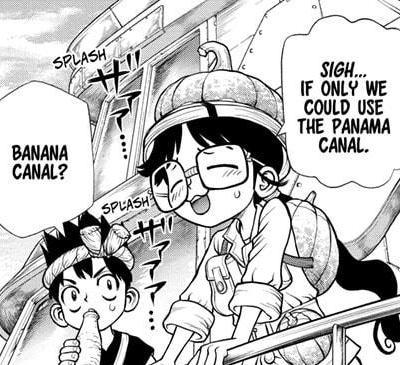

The Suez is a man-made canal that gets drained and cleared every 10 years so the boats can pass through unobstructed. The area has also been mostly desert for thousands of years. Sandstorms would soon fill it in, making it impassable.
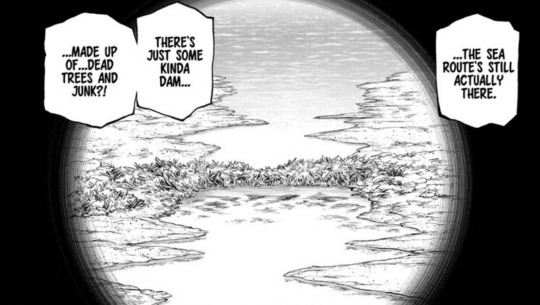
What Ryusui is worried about here is probably similar to the Ever Given back in March, when winds ran it aground, blocking the whole canal. It had to be dug out to be freed, which the KoS can't do here. Turning around or backing up is also impossible if the canal is too narrow.

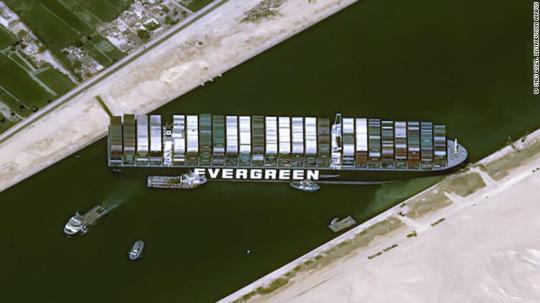
Kohaku is the only power/fighter team member here, and she's definitely making sure to represent the hot-heads! Getting revenge on a canal, trying to destroy things…


Chelsea's old banners made a comeback, which isn't surprising since fabric is tedious to make. Reuse is the basis of Senku's science after all!
But more importantly, how the H-E-L-L did it survive those 7 years when everyone was petrified?!
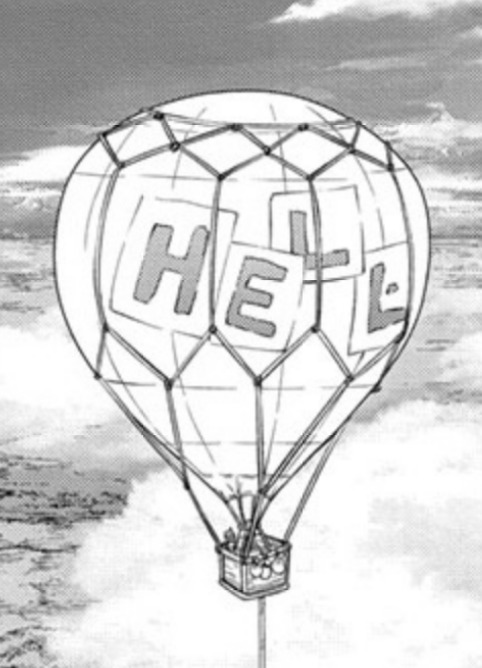
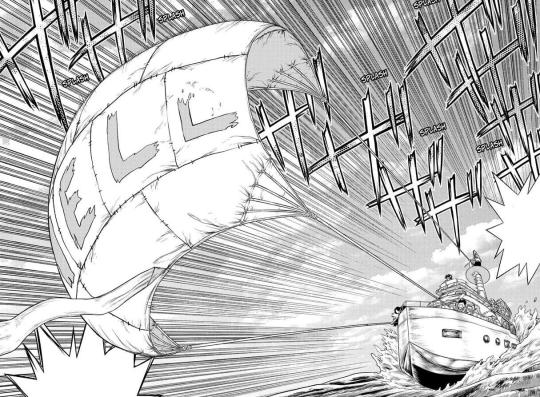

The dam shown looks more like a beaver dam or a deliberate structure than something that naturally got packed like that. The way it follows onto the land is a little odd to me as well… Something could be hiding underneath?

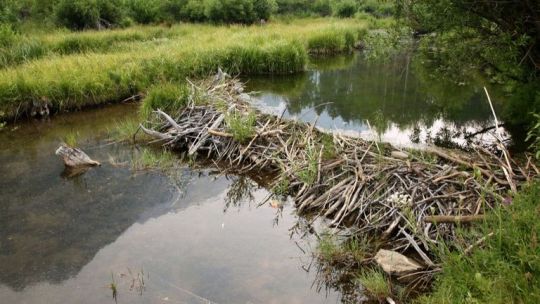
Senku always makes sure to number his rockets.
(I spent too long wondering if this was a pun, but the i-shi/stone pun is for 1-4, and "Dr. One" doesn't quite fit how "Dr. Stone" is pronounced…)

The rocket has two sets of controllers, one used by Senku on the ship and the other by Ryusui about half way to the dam. It's unlikely that this choice is due to range issues, as the cell phones worked 80 km apart and this is only 20 km.

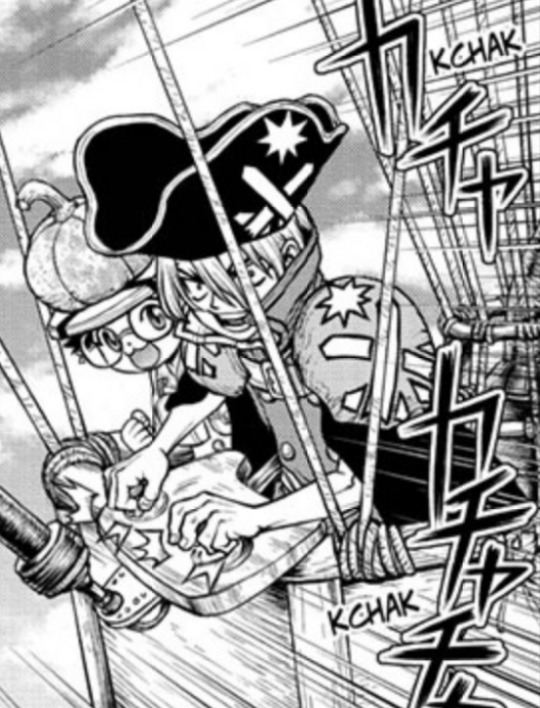
It's probably so that Ryusui can pinpoint the landing while Senku takes care of the launch.
The coordination between them is impressive!

India has likely been chosen as Math City because of its long history of mathematics dating back over 3000 years, before Europe had made similar advances. They invented many important concepts, such as negative numbers, the idea of zero, and decimal points.
The other option for India being Math City is that it has many natural resources useful for making computers and other electronics, however I think we'll have to wait until future chapters to see why they chose it!
12 notes
·
View notes
Note
how was march's companion quest (if you did it yet)
i did it the second it came out. a bit disappointing but not surprising BUT i did like some of it and it had an interesting confirmation.. like i expected nothing from it and didn’t get much, but at least it wasn’t net zero. ill put more detail/spoilers down there
i liked the scene on the express with everyones reactions to first finding march in that ice. cool that dan heng was the one to chip her out of there and what he said to her was really sweet. and it’s interesting that apparently it was fuli herself (or another aeon but cmon) who sealed away march’s past memories because they’re incredibly painful, given the examples of an eagle falling from a cliff and a ship running aground. but i mean the fuli thing was super obv so i would have liked an actual little tidbit of smth before the ice? not just yea it sucked :/ like ok cool.. can you elaborate just a tiny bit more.. AND THEN WE GET A LIGHT CONE BUT ITS NOT AN ACTUAL LIGHT CONE ITS JUST A THING 😭 i rly thought it was an actual cone i was like ooh nice! but no we just have to keep march’s nudes in our inventory
4 notes
·
View notes
Text
Hyperlinks to all the other songs OP mentioned:
Local King Realises He Has Zero Useful Skills
Gay Bar Anthem About Undressing An Oblivious Straight Guy
The Ruling Class Sucks, How About We Poison All Of Them
The Most Scathing Critique Of Representative Democracy You Will Ever Come Across
Yelling About How You're Going To Very Sneakily Kill Your Brother
Pirate Shanty: Run Aground Edition
Disney Princess Love Interest Duet Except The Lyrics Are About How You Barely Tolerate Each Other (twice)
ah yes, Galavant, the musical comedy fantasy show with bangers such as
"Local King Realises He Has Zero Useful Skills"
"Gay Bar Anthem About Undressing An Oblivious Straight Guy"
"The Ruling Class Sucks, How About We Poison All Of Them"
"The Most Scathing Critique Of Representative Democracy You Will Ever Come Across"
"Yelling About How You're Going To Very Sneakily Kill Your Brother"
"Pirate Shanty: Run Aground Edition"
"Disney Princess Love Interest Duet Except The Lyrics Are About How You Barely Tolerate Each Other" (twice)
and of course
"A New Season AKA Suck It Cancellation Bear" which is the actual real title of that song and cannot be improved upon through humorous description
also have I mentioned that all of these are composed by actual real Disney composer Alan Menken, of Little Shop of Horrors, Tangled, and basically the entire Disney Renaissance fame, and wow do they sound like it
9K notes
·
View notes
Photo

Aground Zero - прокапываем путь на поверхность
Воксельный симулятор колонии и ролевая игра Aground Zero для Linux и Windows ПК от разработчиков из компании Fancy Fish Games. Игра уже доступна в Steam Early Access с 85% положительных отзывов.
https://www.gamebuntu.ru/review/aground-zero-prokapyvaem-put-na-poverhnost/
0 notes
Text
By • Olalekan Fagbade Governor’s absence, strategy to avoid giving report of one-year stewardship – APC alleges The All Progressives Congress (APC) in Osun State has condemned the continuous absence of the state governor, Ademola Adeleke, in the state Government House, describing it as a strategy to avoid giving report of his one-year stewardship. It will be recalled that the governor's spokesperson, Olawale Rasheed, had in a recent statement claimed that his principal has embarked on a working vacation to Europe and Asia. Mr Rasheed had said that the governor's trip was to finalise partnership deals with investors and development partners. However, the Osun APC, in a statement signed by the Chairman, Tajudeen Lawal on Sunday, condemned Mr Rasheed's claim, saying it is full of contradictions criminally packaged to hide some information. The party claimed that the governor, contrary to Rasheed's statement, has been holidaying in the United States of America in the last two weeks. It said: “Of course, this is a mere prelude to a foundation-laying for excuses that Governor Adeleke would not be physically present in the state for the celebration of his one-year administration coming up tomorrow. “It was reliably gathered that a recorded statement from the governor would be played for the people of the state in lieu of his physical presence tomorrow. “No one can begrudge another for falling sick or nursing an ailment as such is beyond the control of any human being but God Almighty, however, it beholds on those who are holding the people’s mandate in trust to always tell the truth and stand by the truth. “We know very well that Governor Adeleke has absconded from the state so he would not be able to give due account of his stewardship to the people of the state. “Since November 2022, when he came on board, Governor Adeleke has run the state aground with his sheer incompetence, lack of proper education and his zero administrative acumen. “He is afraid to disclose to Osun people how he has mismanaged over N130 billion in revenue accrued to his government in the last one year. “He is afraid to tell them how he has allocated in the supplementary budget over N10 billion for his food, entertainment and office use while parents of UNIOSUN students are struggling to pay increased school fees his regime forced on them to pay. “Governor Adeleke is ashamed to face the Osun people that one year after, his promise of making Osun another Dubai is a fluke. “Adeleke is distraught to face Osun people because he has failed to provide palliative for them in the face of economic hardship occasioned by the removal of fuel subsidy and the N9billion he collected from the Federal Government, his demonic government has looted it. “Adeleke is afraid to face the anger of Osun people that while a serious state like Ogun is investing in Compressed Natural Gas (CNG) buses, which is capable of making the cost of transportation cheaper, Adeleke in a ploy to line his pocket, is putting Osun money in unsustainable diesel-propelled vehicles purchased over 10 years ago.” The Osun APC also claimed that Adeleke would be laying a dangerous precedent with his absence from the first anniversary of his administration on Monday, as it would be the first time that such would happen in the history of the creation of the state.
0 notes
Text
interesting massive disconnect between "mainstream" media and the actual opinion of the vast majority of people on earth.
I can't recall a time when it's been clearer - I can't recall an issue TV (as it were) didn't bend pretty much instantly to public opinion in some way
the ship is running aground. it's no good development, no good omen! to say "it took blatant genocide to wake people up!" would be naive and aimlessly optimistic at best. it's just bringing antisemitism to the surface in a lot of people - evangelicals unused to having a great excuse to hate Jewish people, which feels more natural to them than singing hosannas to living Israelis. Most arguments are still talking about a "conflict" - as if there's a moral imperative to really explore whether or not you, personally, deserve to be violently murdered by a nation? that's preventing you from escaping your own violent murder?. Many are repeating arguments coined in the 20th century that make zero sense today, but seem unaware of it. Those that have known for a long time what the state of things is vis à vis nations versus subjugates aren't gaining any new insights! They're sounding alarms containing all the same words that antifascists have been using for a century.
There's very little waking up going on!
What's happening is global panic. Loss of coherence + increasingly random action.
1 note
·
View note
Text
The 2023 Fastnet Race set sail with 430 yachts on July 22 – up from the previous record of 388 that took the last pre-COVID race in 2019.
While pundits were comparing the wind for the 50th edition to that of the last Fastnet Race in 2021, in fact it was gustier with a densely overcast sky, drizzle that built to rain, and enough mist to obscure the mainland.
However, what was consistent was the heinous washing machine sea-state that competitors encountered at the western exit of the Solent at Hurst Narrows, as they passed the Isle of Wight’s most famous landmark, the Needles and beyond. As usual this built increasingly with the ebb tide, especially affecting the smaller yachts.
It was a brutal first night at sea with numerous retirements and many others seeking temporary shelter from the gale force conditions in the English Channel.
By the first morning, 86 had officially retired, comprising 78 across the IRC fleet (the biggest number being 27 in IRC Two) plus two Class40s, two IMOCAs, three MOCRA multihulls and one Ocean 50 trimaran.
In the severe conditions, HM Coastguard reported involvement in 28 incidents, including one sinking. Said the event statement, “At approximately 16:30 yesterday afternoon the Sun Fast 3600 Vari began to take on water southwest of the Needles. Thanks to the swift response of the emergency services both crew members were evacuated to Yarmouth, Isle of Wight and are safe and well. The boat is believed to have sunk although the exact reasons are not yet confirmed.”
Several calls to HM Coastguard were to do with injured crew. Otherwise, four yachts dismasted – Heather Tarr’s Yoyo from Ireland; Nick Martin’s Diablo; Bertrand Daniels’ Mirabelle and Tapio Lehtinen’s Swan 55 yawl Galiana (due to compete in the Ocean Globe Race shortly).
In addition, Azora sustained broken steering, Dulcissima a loss of rigging, while Richard Matthews’ CF520 Oystercatcher XXXV sustained deck failure and Oida ran aground after her anchor dragged.
There were several other incidents in which HM Coastguard was not involved, including the mast foot exploding on Long Courrier who retired to Cowes – the only occasion race veteran and 2015 winner Géry Trentesaux has retired from this race.
Fifteen registered entries didn’t start, including one of the race favorites – Peter Morton’s Maxi 72 Notorious in IRC Super Zero.
Good news did arrive on day two as after a tough first 24 hours, conditions had abated in the English Channel and Celtic Sea. Between Land’s End and the Scilly Isles, there were reports of 17 knots from 250°, dropping to 15 for the second night, with the wind in the western English Channel typically 10-15 knots.
But well ahead of that was François Gabart and his team on the 100-foot SVR Lazartigue as they crossed the finish line at 21:38:27 BST on July 23, setting a new record of 1 day 8 hours 38 minutes 27 seconds, breaking the time set by Franck Cammas and Charles Caudrelier on Maxi Groupe Edmond de Rothschild two years ago by 36 minutes 27 seconds.
The 32m long by 23m wide, foil-borne, flying Ultim trimarans are by far the biggest, fastest offshore race boats on the planet, with the gale force winds making little impression
“It is never easy to leave the Solent and doing it in an Ultim is even more difficult,” admitted Gabart. “Doing it with 400 boats around you is harder still. And if you do it upwind…in 25 knots…! It is not easy! We were happy to make it out of the Solent. I think if there had been more than 30 knots at Hurst, we wouldn’t have done it. After that the waves were strong, but we could still race and in the end, we broke nothing.”
0 notes
Text
Aground Zero RPG Gives New Life to Base-Building Games

Aground Zero RPG is getting ready to launch the colony sim and base-building game on Linux, Steam Deck, as well as Windows PC soon. All thanks to the creative minds at Fancy Fish Games. Which is still going strong via Steam Early Access with 90% Very Positive reviews. Big news for fans of base-building and survival games— Aground Zero RPG is officially launching out of Early Access on April 4th! After a year of community-driven updates and improvements, Fancy Fish is finally bringing the full 1.0 experience to Linux and Steam Deck. If you’ve been holding off on diving into Aground Zero RPG, now’s the perfect time. This voxel-style colony sim and base-building RPG takes place in the same universe as Aground (2020) but brings a new 3D spin to the adventure. Whether you played the original or not, you can jump right in and start building, exploring, and maybe even taking to the stars.
Survive, Build, and Explore – Solo or with Friends
The world as we knew it is gone. You wake up deep underground with nothing but a quirky AI companion to guide you. Your mission? Find survivors, rebuild civilization, and reach the surface — and beyond. But how you do it is entirely up to you. Science, magic, dragons, spaceships—yes, spaceships! Aground Zero RPG has it all in the mix. And with multiplayer, you can team up with friends for co-op survival, whether on the couch, locally, or online. While offering solid Xbox controller support, which you can find on Amazon.
Aground Zero RPG 1.0 Trailer
youtube
What’s New Since Early Access?
Over the past year, Fancy Fish has packed in tons of content, shaped by player feedback. Here’s some of what you’ll find in Aground Zero RPG at launch:
Multiplayer – Play with friends locally or online
Multiple story endings – Your choices matter
Spaceships! – Build, customize, and explore the cosmos
Dragons – Raise, evolve, and ride them into battle
Magic & Science paths – Become a spell-slinging wizard or a tech-savvy inventor
The Shattered Moon – Build a moon base, because why not?
New planets & space stations – Expand your reach beyond Earth
The title will also launch with full translations in seven languages—French, German, Brazilian Portuguese, Simplified Chinese, Russian, Spanish, and English. so even more players can enjoy the adventure.
The Team Behind Aground Zero RPG
Fancy Fish is a small indie studio led by a husband - and - wife duo, known for crafting unique, quirky titles like Aground (which became a hit in 2020). They’ve poured their passion into development, making it a release where creativity, survival, and exploration collide in the best way possible.
Ready to Play?
You can wishlist or buy Aground Zero colony sim and base-building RPG on Steam Early Access now. Along with support for Linux, Steam Deck (verified), and Windows PC. If you also want to stay in the loop, join the official Discord for updates. Also, don’t forget to check out the game’s original soundtrack by Chase Bethea, available for pre-order now. Mark your calendars — April 4th is when the 1.0 launch takes flight. Whether you’re into colony sims, space adventures, or just like a good survival challenge, this one’s got something for you!
#aground zero#colony sim#base-building#rpg#linux#gaming news#fancy fish games#ubuntu#steam deck#windows#pc#Youtube
0 notes
Text
Nosferatu Part 3 of 3 -- Nosferatu weekend comes to an end, just as all things must come to an end (like 2024 happy new year 🥳)

Version: Robert Egger's most recent entry into the Nosferatu cinematic universe
Movie Snack: traditional popcorn and a soda
(picture taken both for posting reasons and because my mom didn't believe I would make it to the theater in time, because I was pushing it a little bit)
What a journey it has been. It's actually been really interesting to see all three of these films back to back, they make for excellent comparisons of film era and directorial style. I think this is in part because Nosferatu is so constrained in a way that Dracula isn't. Dracula adaptations tend to go off the rails, but Herzog and Egger both stuck to the story beats fairly closely. Nosferatu is so defined by not being Dracula, in the ways that the plot and characters deviate from and converge with Dracula, that I think it would be hard to make a Nosferatu that wasn't faithful to the original. Because then it would just be another wild Dracula adaptation, not one of Nosferatu. But that makes for a really interesting comparison of how the two directions adapt the same story almost identically but with their own style. Where Herzog lets these wide shots of nature really guide the slow, dreamy tone of his version, Egger feels much more modern with a bit more focus on plot and a couple more action-y scenes, along with his signature rich folk horror and historical setting.
There was a lot to enjoy with this version - particularly Egger's embrace of the full necrophiliac themes, pushing the R rating (lol I could see this being another fight over NC-17, I'm glad he finally got his full frontal shot after having to cut it out of The Lighthouse), Willem Dafoe teaming up with the dad from The VVITCH, and the horrible beauty of the ending sequence. That ending was probably my favorite of the three, the moment in the sun and then the 'death and the maiden' closing. There were some downsides. The jump scares weren't really effectively used, I didn't love pulling focus from the plague to zero in on the personal tragedy (I liked the apocalyptic tone of Herzog way more), and I felt like the cinematography wasn't really anything to write home about, it just sort of looked and felt like every other recent historical/folk horror/gothic film. Interestingly, this version scared me the least because Orlok looked so different from the original monster that it didn't activate that deep fear part of my brain.
Unexpected funny moment: when the dad from The VVITCH watches not!Renfield bite into a live pigeon and his response is just like 'my good man, why have you done this?' this is a modern hospital, goddammit, and he's going to be polite
It would be really hard to rank these films because of the way they're all in conversation with each other HOWEVER...I think 1979 takes the crown of my personal favorite. You just can't beat that opening sequence, Isabelle Adjani, and the cinematography (cinnamon topography). The scenes that have direct comparisons between 1979 and 2024, with the exception of the ending, I prefer 1979. (Jonathan/Thomas getting picked up by the hearse, the part where he cuts his hand and Dracula/Orlok advances, the ship running aground, the coffin march). 1979 also scared me the most since 1992's Are You Afraid of the Dark episode, 'Tale of the Midnight Madness'. (Okay, so I didn't quite watch these in chronological order, since I saw that one a very long time ago. Also there's a version from 2023 that keeps popping up on tubi that I suspect isn't good lol.)
Anyway, happy new year! Nosferatu weekend concluded
This liminal space-mas is brought to you by Nosferatu -- PART ONE

At home festive edition.
Version: 1922.
Movie snack: burrito
You know, I had never seen the 1922 Nosferatu before. I've never seen any Nosferatu before because back when I was very smol, we went to visit my mom's friends in New Jersey and their kids were a little bit older than me and were allowed to watch Nickelodeon's Are You Afraid of the Dark?. It happened to be the Nosferatu episode and I was just a littttle bit too young for it and it was a little too scary. To this day, that remains the only episode of Are You Afraid of the Dark? I ever saw and I was also unable to watch Nosferatu because I was TOO scared. There were a couple moments watching this film where I got that little twinge of 'uh oh, scary' as my 6 year old brain activated, which I don't think would have gotten me without that childhood experience. It was bad, I remember having to get up in the middle of the night and go sleep with my parents because I was that scared. I don't want to look it up now because I'm sure it's going to be embarrassingly terrible looking back, but it really freaked me out in 1996 or whenever.
I'm very glad I watched this one first, as watching the trailers for the other two I can see the distinct visual elements that separate it from just being Dracula (aside from the name changes). I noticed that while I was watching the scene where the townspeople are carrying the coffins in a line really jumped out to me, and that's present in both of the other Nosferatu trailers. I don't watch a lot of silent films so I was a little uncertain if I would be able to connect with the characters without spoken dialogue, but I was able to follow everything pretty well. Loved not!Mina.
12 notes
·
View notes
Text
Collision Avoidance
Well, it has to be said that in the early days of the Age of Discovery, the risk of collision on the open sea was zero, even if navigation was not yet fully developed and instead of sailing to the Spice Islands, one sailed around the world just because one had made a wrong turn. That didn't change much when navigation improved, because the number of ships on the seas was not yet as high as it had been steadily increasing since the late 18th century. But if it did come to that, there was only one problem, there was no radio communication, and the chances of someone coming to the rescue were purely coincidental. Communication was by line of sight only, so if a ship came over the horizon as one was sinking, it was purely by chance. It could even be that this ship was the enemy, who were more intent on sinking or capturing you than coming to your aid. In the event of two ships approaching each other, there was no need at that time for formal rules of engagement as to who should change course, when and how. It was more the case that some ships carried lighting at night in the form of the star lantern or a mast lantern to signal their presence, but this was only the case in crowded waters, and the reluctance to display lights at night was due to the desire to avoid giving away the ship's presence to the enemy or pirates.

Two fighting vessels in collision off a headland in choppy seas, by D. Tandy 1798-1805 (x)
Collisions in the harbour or in the Navies anchorages, on the other hand, were much more likely, and the rule was, whoever is smaller gets out of the way first. The first larger and more frequent collisions did not occur until the first steamers appeared. While a steamer was much more manoeuvrable than a sailing ship, let alone much smaller than a ship of the line or even an Indianman, these ships were actually required to clear the way, but unfortunately not many adhered to this rule, which led to accidents.
This led to the fact that from the early 19th century onwards various nations introduced "conventions" for the behaviour of ships in the event of a possible collision, such as ships sailing before the wind giving way to ships sailing close to the wind, because ships sailing before the wind have greater room for manoeuvre in choosing the course they can take. These "conventions" were mainly set at national level, and even then they were not binding, but based on what might be called good seamanship. It was recognised that in a situation where each vessel should have some idea of what the other might do, there had to be some form of coherent action to avoid collision. Ships do not collide with such impunity, and both ship owners and insurance companies would like to see some kind of code that would bring order and predictability to a potential collision situation. Before a uniform set of international rules was developed, there were different practices, conventions and informal procedures developed by different maritime nations in different parts of the world.

"Wreck of the 'Scotland'," Harper's Weekly Magazine, December 29,1866
Off the Long Island coast, near Fire Island, the British steamer Scotland bound for Liverpool ran into the smaller vessel Kate Dyer in an evening collision. The Kate Dyer sank in fifteen minutes and the Scotland, having saved seven of the sunken ship's twenty-man crew, tried to make it back to New York Harbor but ran aground in a sinking condition off Sandy Hook, New Jersey. (x)
As a result, there were inconsistencies and even contradictions that led to unintentional collisions. There was also no standardisation of ships' navigation lights for operation in the dark and of navigation marks in the shipping channels, which led to dangerous confusion and ambiguity between ships at risk of collision. With the advent of steam-powered ships in the mid-19th century, the regulations for the navigation of sailing ships had to be supplemented by regulations for the navigation of motor ships. Sailing vessels are limited in their manoeuvrability in that they cannot sail directly to windward or into the eye of the wind and are not readily navigable in calm conditions.
With the advent of steam-powered ships in the mid-19th century, the regulations for the navigation of sailing ships had to be supplemented by regulations for the navigation of motor ships. Sailing vessels are limited in their manoeuvrability in that they cannot sail directly to windward or into the eye of the wind and are not readily navigable in calm conditions. In contrast, steamships could manoeuvre in all 360-degree directions and are manoeuvrable regardless of wind or calm.

Terrific Collision, between the Steamboats Dean Richond and C. Vanderbilt near Rondout, on the Hudson River, Sept 19th 1867 by which the Dean Richmond was sunk, and several lives lost, by Currier and Ives 1867 (x)
In 1840 Trinity House, the British lighthouse authority, in London drew up a set of regulations which were passed by Parliament in 1846. These Trinity House regulations were incorporated into the Steam Navigation Act, and the Admiralty's regulations on the lighting of steamships were incorporated into that Act in 1848. Note that these laws were aimed at steamships, which were coming into more and more use at the time. In the US, Congress included lights for sailing vessels in the regulations for ships in US waters. Ten years later, an Act of Parliament in Britain required coloured sidelights for sailing vessels, and fog signals had to be given by steamships with the ship's whistle and by sailing vessels with the fog horn or bell, while a separate but similar measure was also taken in the United States, although British maritime law was also adopted in what was probably the first attempt to reach international agreement on maritime practice.
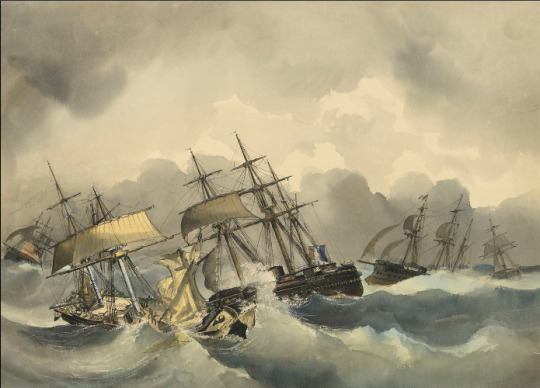
French ironclad in collision, by Jean-Antoine-Théodore, Baron Gudin c. 1870 (x)
In 1863, a new set of rules was drawn up by the British Board of Trade in consultation with the French, initially aimed at regulating traffic in the English Channel. A year later, these rules were adopted by more than thirty shipping countries in a large-scale attempt to reach international agreement. In the US they were called 'Rules to Prevent Collisions at Sea'; this is the first time the term has been used. In the UK they became known as 'The Rule of the Road'. Individual countries introduced their own minor changes to the rules, so it was still complicated for navigators to comply with them, but in 1889 the United States convened the first international shipping conference to consider standardisation. this came in 1899 but proper and binding agreement did not come until after the Second World War.
198 notes
·
View notes
Note
what happened with the russian baltic fleet?
its gonna be an ODYSSEY. for them and us. anyways so. (also this isn't gonna be like an exact timeline just some highlights) setting the scene: its the beginning of the 20th century. Russia and Japan are at war (doesn't matter why something about a port its not important or funny) russia are getting their ass handed to em but then: enter stage left THE RUSSIAN BALTIC SEA FLEET. as the name suggests they operate in the baltic sea which. several problems from the getgo: its cold which means ice which means the lads have to go the long way round like. LONG WAY as in 30k kilometres LONG. the russians didn't have any supply stations along the way. ANY. the crew is mostly made up of peasants with no formal training. the admiral leading this ragtag group is a perpetually angry insane man. so u know not the best starting conditions but nothing a positive outlook can't make up for. or so they think. ANYWAYS the fleet is setting off. finally. huzzah. only to have the flagship of the operation run aground within a minute of setting sail. another ship crashes into another one. mind u they barely felt the harbour at that point. it only gets worse form here. in no particular order: paranoia sweeps across The Fleet. our boys are convinced DEAD SET absolutely sure no doubt about it that they are about to be set upon by an armada of japanese torpedo boats. they are still in waters around DENMARK. a fishing boat approaches them to deliver a message. normal enough occurrence u would think. but. our boys mistook them for The enemy and engaged them in a barrage of bullet fire only to ENTIRELY miss them. like the whole fleet just blasting those tiny fisher boats and not one hit. later one ship of their fleet signaled it been surrounded by EIGHT japanese torpedo boats. panic scrambling ect ect from the rest of the squad. turns out it was a false alarm there were in actuality ZERO japanese torpedo boats. again they are still around DENMARK. anyways they almost cause a huge diplomatic incident with the british (yes they again mistook some fishermen as the enemy) as a consequence they weren't allowed to pass thru the suez canal and had to licherally sail across the world now. some more unprovoked attacks on civilian ships, a trip to magdagaskar for some pets (poisonous snakes, crocodiles) to boost morale, dumping all their meat due to a cooling failure into the ocean attracting a following of sharks, accidentally shooting one of their own ships, a mutiny and more insanity our boys made it to japan! huzzah again! then. a rare technical blunder. the one time they don't think an approaching ship is an enemy vessel it turns out it is. having not realised this yet tho they communicate their position ect. our hero's are decimated on the spot like annihilated like FUCKED = end of the war :)
35 notes
·
View notes
Text
Last Line Tag Game
Thank you to @spindrifters for the tag!
This isn't exactly the last line, but it is the last one that I wrote that wouldn't be too revealing. In the midst of some heavy dialogue, so I included a bit of the context bc otherwise there's zero lol.
"[...]That ship has sailed.” “Doesn’t mean I can’t steer it,” Remus put out hoarsely. “You’re not steering shit, you’re running it aground.”
I'm gonna fling some tags to @black-sparroww @allalrightagain @femme--de--lettres @mkaugust aaaaaaaaaaaaand @inmyownlittlecorner5, ZERO pressure for anything, just wanted to actually tag some folks this go round <3
#remus lupin#just having his 394th daily existential crisis#don't mind him he's fine#he is so fine#doing great#best he's ever been in his life.#this is a very happy passage#no angst here#nope. not from me.#i am a fluff writer now.#hp#tag game#lp writes#responses#last line tag game
8 notes
·
View notes